Virtual Reality
-
- Design’s Future 3D Modeling, Virtual Reality Wave of Design Future Maritime Reporter, Sep 2014 #40
Rooted in early computer-aided design (CAD) and manufacturing applications, design and construction software is firmly at the helm of most shipyards today, enabling the production of better designed, more efficient and consistently built ships produced with measurably less waste: less waste of time, materials, man hours and most important, money. The ROI can be substantial, and is traceable throughout the entire process, across all sub sectors such as project management, purchasing, materials, labor and build sequencing.
For example, in terms of production planning, “the same outfitting job being done in the workshop, when done at dry dock or in the final stages can cost up to 15 times more. The customer tells us that the more you can anticipate in the early stages, the more money you save,” said Stephane Neuveglise, Product Business Manager at Aveva Group plc.
Rafael de Góngora, General Manager of Sener Marine, agrees “It’s a matter of money: The earlier the decisions have the greatest economic impact.”
It’s estimated that virtually all first- and second-tier shipyards use some form of naval architecture and construction software – ranging from the old man of the design software market, rudimentary AutoCad, to more sophisticated versions of Autocad and even more feature-rich products offered by the small cluster of companies that dominate the market.
Key players include Sener, Aveva, SSI and Dassault Systemes.
In the first piece of this three-part series on ship-building technologies, last month we looked at how the movement of naval architecture from paper to computers has dramatically impacted and changed the process of ship design and construction for the better, where those changes have taken place, and what the payout for shipyards has been [MREN August 2014, “Soft Solutions: The Evolution of CAD/CAM].
This month’s installation will take a closer look at some of the providers of the technology driving down the need for costly rework orders and in some cases, responsible for eliminating tedious and error-prone tasks of yesteryear, and talk to them about the changes they see cresting above the market.
SENER
To hear Sener Marine GM de Góngora tell it, competitors are many in the market for ship design and construction software – and they fall into one of two distinct camps: Ship design software, and general, typically AutoCAD-based CAD software that can be used for ship design.
“In the first group, we are not so many; maybe half a dozen, if we speak about companies with some importance,” says de Góngora, positioning Sener as one of the three main vendors in the ship design CAD software market, and tagging UK-based Aveva as one of its main competitors. In the second group, the number of competitors is greater, and increasing.
FORAN, Sener’s venerable offering in CAD ship design, was introduced in 1965 and will celebrate its 50th anniversary next year – an astounding milestone for any piece of software, especially today in an era where application life cycles often run three years or less. It is estimated that FORAN has been involved in the design and construction of over 1,000 vessels worldwide. It is currently used in more than 150 ship design offices and shipyards in 30 countries.
Longevity is actually one of the attributes of de Góngora‘s “first group.” The key players in the ship design application market – Sener (58 years/Spain), Aveva (47 years/UK) and Dassault Systemes (33 years /France) - are all long-time players, with British Columbia-based SSI the youngest, notching 24 years in the business.
Also key to several of these players is a background in naval architecture and marine engineering. Like Aveva, Sener, for example, was founded by a marine engineer, Enrique de Sendagorta, and initially focused solely on marine projects. The company over time expanded into other industries, but its core ship design software was developed by Sener architects seeking to solve their own problems. Eventually, the company realized that it had a product that could be sold to other architects and ship yards, leading to FORAN’s debut.
Of course, as de Góngora notes, the FORAN of yesteryear has nothing in common with the system the company is currently marketing, which was most recently updated in July (FORAN V7OR3.0). The technology has changed, obviously - think three-dimensional (3D) and virtual reality - but more important, the design process has changed as well
FORAN today is an integrated CAD/CAM/CAE system that can be used in the design, production and manufacture of ships. Subsystems run the gamut from hull structure to machinery, to outfitting, electrical and drafting and mechanical designs. “Expert add-ons” include a PLM link, virtual reality and Control Management. All information is stored in an Oracle database. Among other changes, the most recent version enables the visualization of the ship 3D model already generated in FORAN into a virtual reality environment, two areas Sener and it’s competitors see as key to the future.
The Windows-based system comprises several application packages, a number of common modules (build strategy, 2D drafting, 3D walk-through design review, concurrent engineering), links with production equipment, interfaces to management systems and an integrated development environment. There are two major lines of business: the design of ships and marine structures, and the development of FORAN, its design and construction software that now boasts worldwide commercial success.
Key to FORAN’s endurance, believes de Góngora, is its ability to provide a single solution from the first stage of the design to the complete assembly and delivery of ship, without requiring the assistance of any third-party software. While the company doesn’t provide product lifecycle (PLM) management, it does provide a link to those products. “We are the only one who can provide a single solution,” de Góngora claims.
The transformation of the industry, meanwhile, during FORAN’s expansive lifespan, has been “dramatic,” resulting in measureable benefits, according to de Góngora. “One benefit is time. This is very important in the ship building industry. We have shorter delivery times compared with 25 years ago, because the time required to build, assign and construct is much shorter.”
This, despite the added complexity in ships being designed today. Even in the face of more complex ships, CAD design packages help ship builders to continue to win the race for shorter delivery times. More complex operations of the ship require more complex technology. And that complexity in a product, says Aveva’s Neuveglise, helps drive the need for more 3D. For example, the more equipment in a given space, the more you need to be able to see in 3D to be able to navigate the area, and the earlier in the process the modeling is done, the better.
“Doing more in the same space of time is actually an advance,” says SSI CEO Darrell Larkins, adding that today, it’s not so much about being able to do the same thing more efficiently, but rather, about the ability to do more. Put another way, he said, “Software might let you do something a thousand times faster when what you are really trying to accomplish is 1,000 times more complex.”
On top of the savings in time, shipyards can achieve a significant reduction in materials waste and cost because design software enables accurate fabrication information and in essence, guarantees no interferences. Scrap from construction of parts is then reduced to minimum.
So what kind of ROI are we talking about? “If you are in a shipyard that is not highly tech-oriented, you could see savings of 30% to 50%. If you take into account a state-of –the-art shipyard, the improvement is less. We are speaking about 10% in worst cases. But this is something. Ten percent in the price of a ship is many millions of U.S. dollars,” says Sener’s de Góngora.
Another way to tackle waste and push consistency is to enable information about modifications and the data collected in the PLM system to be sent back up the information chain into the computer-aided process planning (CAPP) system from the PLM package, something Sener and Aveva are working on.
“If you are building more ships of one class, the second ship is almost equal. The third and fourth are not the same – some modifications will have been made.” Transferring those changes back down the line will enable those modifications to be made to subsequent ships far more easily, notes de Góngora.
Sharing that data more quickly, “I guarantee there will be more consistency between the phases of design than before,” said Neuveglise
This is where Aveva touts the benefits of adopting the concept of lean manufacturing from the auto industry. Invented by the founder of Toyota, lean manufacturing is about how to be more efficient in production. It is based on no waste, respect of everyone and their job, and a continual feedback loop at all levels. It’s the concept of providing feedback from production back to the design stage that really intrigues Aveva.
“Sometimes when doing a detailed design, you find something that is not easy to do, or which needs to be further fabricated. So production tells the guys in basic design, ‘Don’t do that anymore for future reference,’ ” says Neuveglise. It’s even more important in shipbuilding because unlike automobile manufacturing, which is designed and built sequentially, in ship building, it’s all done at the same time, which makes the process much more complex. “So if something is discovered in the detailed design phase, you need to tell the folks in basic design, and until recently, we weren’t able to have this kind of feedback,” he adds.
That will change in the next generation of ship design processes as software will need to address two issues, in de Góngora’s view:
• Collaborative design on a global level. “The ship building industry is a paradigm of globalization,” he says, noting that the design, various parts of the ship, the basic ship, the owners and suppliers typically are spread out around the world. “We need to keep working on a collaborative solution for all these geographically-dispersed partners.”
• Increased use of 3-D software, which traditionally is used more in product design, than in the earlier stages of the design. “This is important because the most important decisions in design are made at the earliest stage where you are defining all the main parts of the ship.” All the decisions you make at that stage have consequences,” said de Góngora.
SSI
Sener won’t get any argument from SSI, which is a big proponent of 3-D software and any form of communication that leads to better design decisions made earlier in the process. In an April blog post, CEO Larkins crowned communications as “the most significant contributing factor to the success of ship yards.” By which he means all the steps involved in the effective creation, sharing, dissemination and management consumption of information. “The shipyards who are good at determining not only how and when information will be shared, but also where, why and with who . . . are more effective and more successful,” he explained.
In fact, SSI, formerly known as ShipConstructor Software Inc., is all about three things:
• Proudly Open Architecture. Notes CTO Denis Morais in a July post, “I love the idea of keeping ShipConstructor 100% purely open and competing with our competitors solely on benefit to the users. There is not a single piece of information that ShipConstructor hold hostage in a proprietary format.’’ SSI walks the walk on Open Architecture with its membership and participation in programs and study projects at the US National Shipbuilding Research Program (NSRP), The Autodesk Developer Network, Autodesk University, VIATeC, SNAME and RINA.
• Fostering better communication, collaboration, and information flows, as early and frequently as possible, with its customers, and between the various stages of ship design and production, as noted above in Aveva’s embrace of lean manufacturing.
• And getting customers to understand that it’s not just knowing what information to gather and where it’s located, but knowing why you are providing it that is really key. Over engineering, or too much information, can cloud an otherwise clear piece of instruction, and lead to mistakes that will have to be reworked.
The company is trying to move itself into more of a consultative relationship with its old customers and newer off shore clients. According to Larkins, SSI wants to look at the bigger picture a bit more, taking on issues like managing information flow while increasing its focus on providing services.
Spend a little time perusing the company’s various blogs written by SSI executives, including Larkins, and the shift to bigger picture thinking is clear. And they want their clients thinking too. In particular, Larkins likes to “lift the curtain” on SSI’s popular ShipConstructor package, and explain the business and technical thinking behind and impact of, the changes, approaches and upgrades in the product line, or point to an issue driving those changes, and talk about how to address it.
The company provides a lot of avenues through which customers can seek support or provide feedback, and recently added one more: Client Councils, which gather together user representatives from narrow industry sectors and regions, to advise the company on addressing their specific requirements. “Both technology and industry requirements are evolving quickly so our clients continually need to adapt,” said SSI CTO Denis Morais.
The initial Client Council consisted of Vripack, Peters Shipyards, Royal Huisman, Vera Navis, Marine Technologies Ltd., BMT Nigel Gee, Mustang Marine, Skipskompetanse, and Pendennis. Some of the groups’ requests were featured in the new release: the split plate command, a new fillet cut type for stiffener end cuts, increased pipe and HVAC connection tolerance, and the ability to create MarineDrafting views in other types of drawings. That’s the kind of response that engenders loyalty.
Ship Constructor seems to turn up everywhere, often at shipyards and architectural practices that have been with the product since its early days as CADLink in the late’80s. Joe Comer, principal of Ship Architects, Inc., claims to have bought the first ShipConstructor license from founder Rolf Oetter in 1988, moving his design process off a mainframe onto a PC. Comer still uses ShipConstructor today. According to the company, the majority of U.S. Naval warships are now built with the SSI solutions. The U.S. Coast Guard also has taken notice, according to Morais, and is asking for ShipConstructor –compatible deliverables on bids for its OPC Program. SSI’s flagship product, ShipConstructor serves the shipbuilding and offshore industry, and is an AutoCAD-based 3D Product Modeling and Production Planning CAD/CAM suite running on Microsoft’s SQL Server. When announcing his appointment as CEO, Larkins stressed the company’s commitment to delivering tools that are user friendly, scalable, easily adopted and implementable with minimal IT requirements. SSI combines support for the native DWG platform with industry-specific standards, terminology and best practices, and the ability to share engineering data with other business processes and applications such as MRP, ERP or PLM tools. The company claims that ShipConstructor’s Marine Information Model provides true Concurrent Engineering for the first time in shipbuilding CAD/CAM, enabling all engineering disciplines to work within a single integrated environment with associativity that extends to the production drawing level. A side benefit of SSI’s support for Autodesk and other standards is that ShipConstructor is said to require little training and gives client a much broader labor pool.
AVEVA
Cambridge, England-based Aveva provides a family of integrated engineering design and 3D design, CAD products. The 45-year-old company is also focused on offshore clients, concurrent engineering and global collaboration. It sees its mission as enabling the creation and management of complex digital assets, allowing customers to work globally with less risk, shorter lead times and greater business efficiency throughout the lifecycle of their physical assets.
AVEVA Marine is a set of integrated applications provides engineering design and information management software to the marine and plant industries. This combination provides a level of technology integration, enabling collaboration with plant industry specialists on the most complex vessels or offshore projects, concurrent engineering, and supports highly collaborative “global virtual’’ shipyard’ projects.
Its naval architecture and hull design capabilities have been developed over more than 30 years in partnership with many of the world’s leading shipbuilders. AVEVA Enterprise offers specialist shipyard resource management capabilities enabling an efficient and integrated shipbuilding process, from initial concept to final handover.
Aveva MARS is an enterprise resource management (ERM) package with modules including Material, Planning and Production.
Last month, Aveva launched Aveva Information Standards Manager (ISM), which governs asset information using a standards-based methodology.
This is the 2d in a three-part series on Ship design and construction. Next month, the final piece will examine the fleet management and operations software market, and how those applications can help owners and operators successfully reduce and control costs while protecting profit margins.
(As published in the September 2014 edition of Maritime Reporter & Engineering News - http://magazines.marinelink.com/Magazines/MaritimeReporter)
-
- Maritime Simulation “A-to-Z” Maritime Reporter, Mar 2015 #38
of ARI with a background in marine engineering (MERI, Calcutta) and robotics and control systems (Stanford University, CA). He has long specialized in virtual reality and robotics technologies and their application in the creation of innovative, immersive learning solutions. To that end ARI Simulation today
-
- MTR100: Global Maritime Mooring Group Marine Technology, Aug 2016 #22
mooring solutions to the offshore oil and gas, dredging, and marine renewable energy industries. Global Maritime Vryhof recently introduced its virtual reality moorings experience where - through virtual reality glasses – people are able to walk on the seabed and inspect the moorings of different kinds
-
- How Augmented Reality Technology Could Transform Shipping Maritime Reporter, Nov 2017 #26
to improve business processes and employee performance and it’s no wonder many companies are getting excited about its potential. While virtual reality completely immerses people in a computer-generated world, AR overlays computer-generated images on the real world. A great example of how
-
- Maritime's Amazing World of Mixed Reality Maritime Reporter, Feb 2019 #36
receive expert guidance on how to fix any problems you detect? The stuff of imagination? Not now. Intrigued? Then read on...Mixed reality: not just virtual reality, but a whole new concept in which any object with a complex internal structure can be fully, not just represented, but reproduced as a fully three-dime
-
- Inside The Apprentice School at Newport News Shipbuilding with Dr. Latitia McCane Maritime Reporter, Aug 2021 #38
fortunate this year is how do you do technical training in this pandemic? And so we’ve been fortunate enough to be able to bring in some augmented and virtual reality training,” said Dr. McCane. “We’ve been fortunate to be able to get federal and state funding, to help us with the technology that we need to
-
- One-on-One with Martin McDonald, SVP, ROV Division, Oceaneering Marine Technology, Feb 2019 #34
that are communicated directly to engineers onshore so they can then make asset-integrity decisions quickly. The images can also be built into a virtual reality environment, effectively digitizing the field and enhancing subsea navigation. Traditional methods use sonar and acoustic navigation, but virtual
-
- Deltamarin And Almaco Join Together Maritime Reporter, Apr 2000 #18
, began his career as a project engineer with the company. Prior to joining Deltamarin, Aarnio was a manager of project department and the virtual reality group at Deltamarin Helsinki. Circle 54 on Reader Service Car
-
- When It Comes to Inspiring Innovation, 'X' Marks the Spot Marine Technology, Aug 2016 #38
had access to in the past. We are seeing exponential advances in sensor technologies, artificial intelligence, robotics, synthetic biology, virtual reality, 3D printing to name a few. Collectively, we are poised to be able to address some of the greatest challenges we face through these advances in
-
- Maritime Tech Trends Digital Maritime Reporter, Jul 2018 #32
Intelligent AwarenessRolls-Royce has developed an Intelligence Awareness System displayed on a touch-panel, which has four user interface modes. Virtual Reality in 2D and 3D, Augmented reality and Precision mode. The Precision mode displaces accurate distances between the user and surroundings, particularly
-
- Transas Releases New Version of Engine Room Simulator Maritime Reporter, Nov 2003 #98
workstations have been given a more realistic and ship-like look. Another major improvement implemented in this new version of simulator is the 'virtual reality' engine room. The innovative 3-D Engine Room module inserted in the ERS 4000 helps users to solve such training tasks as equipment familiarization
-
- Interview: Jeong-kie Lee, Chairman, Korean Register & IACS Maritime Reporter, Oct 2018 #16
and ship classification industries. Currently, significant R&D and specific projects in the fields of cyber security, autonomous vessels, big data, virtual reality and drones are being conducted. In addition, linked to the International Maritime Organization (IMO)’s e-Navigation strategy, the Korean Ministry
-
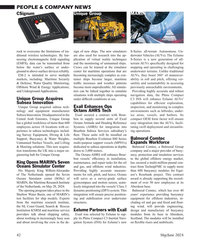 )
May 2024 - Marine Technology Reporter page: 42
)
May 2024 - Marine Technology Reporter page: 42. By har- are also used for research into the ap- derwater Vehicles (AUVs). The Eelume nessing electromagnetic ? eld signaling plication of virtual reality techniques S-Series is a new generation of all- (EMFS), data can be transmitted from and the monitoring of unmanned ships. terrain AUVs speci
-
 )
April 2024 - Maritime Reporter and Engineering News page: 35
)
April 2024 - Maritime Reporter and Engineering News page: 35, oil spill detection and recovery simulations and all-en- fun, he says. compassing safety and crisis management drills. There are practical bene? ts. Virtual reality headsets with the The ABS Global LNG Academy in Qatar features Meta- right training package can instruct seafarers how to use spe- SHIPs simulators
-
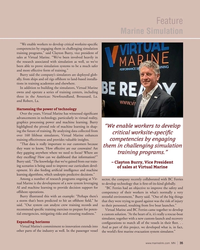 )
February 2024 - Marine News page: 35
)
February 2024 - Marine News page: 35Robert, La. Harnessing the power of technology Over the years, Virtual Marine has witnessed signi? cant advancements in technology, particularly in virtual reality, graphics processing power and machine learning. Burry highlighted the pivotal role of machine learning in shap- “We enable workers to develop
-
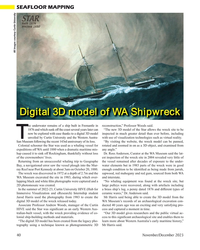 )
November 2023 - Marine Technology Reporter page: 40
)
November 2023 - Marine Technology Reporter page: 40much greater detail than ever before, including Tunveiled by Curtin University and the Western Austra- with use of visualization technologies such as virtual reality. lian Museum following the recent 143rd anniversary of its loss. “By visiting the website, the wreck model can be panned, Colonial schooner the
-
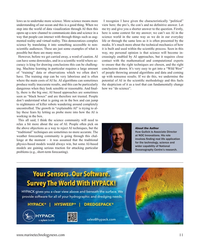 )
November 2023 - Marine Technology Reporter page: 11
)
November 2023 - Marine Technology Reporter page: 11AI in the way that people can interact with through things such as aug- science world in the same way as we do in our everyday mented reality and virtual reality. This democratizes complex life or through the same lens as it is often presented by the science by translating it into something accessible
-
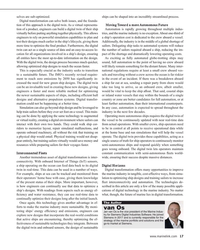 )
December 2023 - Maritime Reporter and Engineering News page: 17
)
December 2023 - Maritime Reporter and Engineering News page: 17the next few decades. ing can be done by applying the same technology to augmented Operating more autonomous ships requires the digital twin of or virtual reality, creating a digital environment where sailors can the vessel to be continuously updated with near real-time data interact with their own two
-
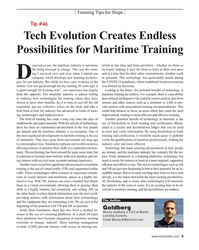 )
April 2023 - Maritime Reporter and Engineering News page: 9
)
April 2023 - Maritime Reporter and Engineering News page: 9more recent but signi? cant advancement in maritime ef? cient and effective way. The newest technologies such as AR training is the use of virtual reality (VR) and augmented reality and VR are just now beginning to hint at their potential for an in- (AR). These technologies allow trainees to experience
-
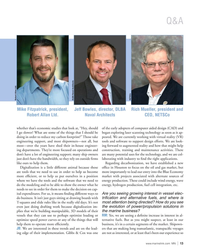 )
September 2022 - Marine News page: 13
)
September 2022 - Marine News page: 13exploring laser scanning technology as soon as it ap- doing in order to reduce my carbon footprint?” Those take peared. We are currently working with virtual reality (VR) engineering support, and most shipowners—not all, but tools and software to support design efforts. We are look- most—over the years have
-
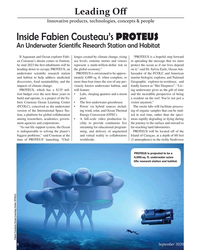 )
September 2020 - Marine Technology Reporter page: 8
)
September 2020 - Marine Technology Reporter page: 8to solving the planet’s ming, and delivery of augmented PROTEUS will be located off of the biggest problems,” said Cousteau at the and virtual reality to collaborators Island of Curaçao, at a depth of 60 feet time of PROTEUS’ launching. “Chal- worldwide. (3 atmospheres) in the richly biodiverse
-
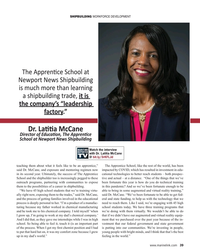 )
August 2021 - Maritime Reporter and Engineering News page: 39
)
August 2021 - Maritime Reporter and Engineering News page: 39pandemic? And so we’ve been fortunate enough to be “We have 45 high school students that we’re training virtu- able to bring in some augmented and virtual reality training,” ally right now, exposing them to the trades,” said Dr. McCane, said Dr. McCane. “We’ve been fortunate to be able to get fed- and
-
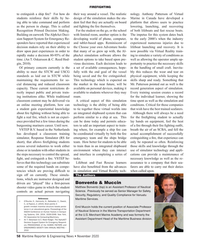 )
November 2020 - Maritime Reporter and Engineering News page: 58
)
November 2020 - Maritime Reporter and Engineering News page: 58books lifeboat launching and recovery. It is draw upon past experiences in order to that many of us grew up with, the Al- now possible via Virtual Reality train- rapidly make a decision 80-95% of the phaAct simulation software allows the ing to simulate a variety of conditions as time. (An T.
-
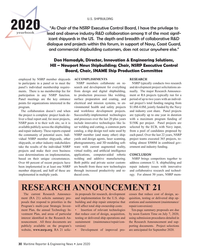 )
June 2020 - Maritime Reporter and Engineering News page: 30
)
June 2020 - Maritime Reporter and Engineering News page: 30the results of the individual NSRP ware with current augmented reality, ernment and industry funding. projects and make their own business virtual reality, and artifcial intelligence case determinations on implementation, applications, computer-aided robotic CONCLUSION based on their unique circumstanc
-
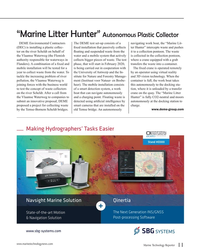 )
January 2020 - Marine Technology Reporter page: 11
)
January 2020 - Marine Technology Reporter page: 11with The ? xed crane is operated remotely year to collect waste from the water. To the University of Antwerp and the In- by an operator using virtual reality tackle the increasing problem of river stitute for Nature and Forestry Manage- and 3D vision technology. When the pollution, the Vlaamse Waterweg
-
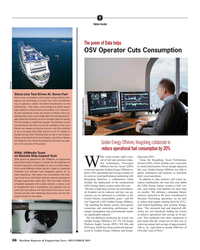 )
December 2019 - Maritime Reporter and Engineering News page: 36
)
December 2019 - Maritime Reporter and Engineering News page: 36berg since 2015. RINA signed an agreement with VRMedia, an augmented iad of fuel and emission reduc- Using the Kongsberg Vessel Performance and virtual reality company, to boost the de-velopment of tion technologies, Norwegian System (VPS), which includes new vessel data remote inspection technologies
-
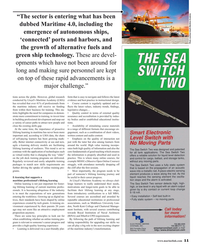 )
December 2019 - Maritime Reporter and Engineering News page: 11
)
December 2019 - Maritime Reporter and Engineering News page: 11high quality of information and also the continue with the application of technologies such core fundamentals of good teaching which ensures as virtual reality that is changing the way “older” the information is properly absorbed and used in on the job deck training programs are delivered. practice
-
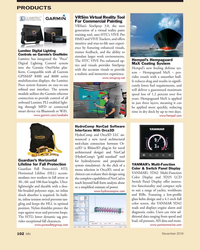 )
November 2019 - Marine News page: 102
)
November 2019 - Marine News page: 102PRODUCTS VRSim Virtual Reality Tool For Commercial Painting VRSim’s SimSpray 3.0, the next generation of a virtual reality paint training tool, uses HTC’s VIVE Pro HMD and VIVE Trackers, and offers intuitive and true-to-life user experi- ence by featuring enhanced visuals, Lumitec Digital Lighting
-
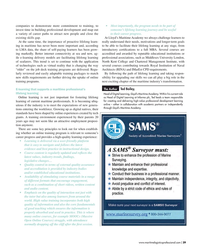 )
Sep/Oct 2019 - Maritime Logistics Professional page: 29
)
Sep/Oct 2019 - Maritime Logistics Professional page: 29seafarers. This trend is set to continue with the application North Kent College and Chartered Management Institute, with of technologies such as virtual reality that is changing the way several courses contributing towards Royal Institution of Naval “older” on the job deck training programs are delivered
-
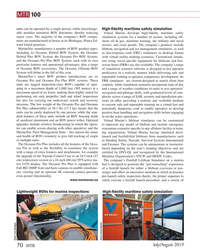 )
July 2019 - Marine Technology Reporter page: 70
)
July 2019 - Marine Technology Reporter page: 70Hybrid ROV System, the Oceanus as fast-response craft (FRC) simulators in desktop format Hybrid Plus ROV System, the Oceanus Pro ROV System, with virtual reality training scenarios. Customized simula- and the Oceanus Pro Plus ROV System, each with its own tors using vessel-speci? c equipment for lifeboats
-
 )
August 2019 - Marine News page: 89
)
August 2019 - Marine News page: 89on the project. http://voith. part of the Voith Group. com/corp-en/industry-solutions/marine-technology.html The Case: VRSIM, INC. VRSim develops virtual reality training systems for painters, welders, and the skilled trades. Products provide hands-on training with deeper performance insights. VR- Sim’s
-
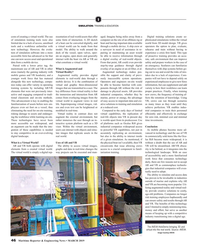 )
March 2019 - Maritime Reporter and Engineering News page: 46
)
March 2019 - Maritime Reporter and Engineering News page: 46What is Augmented and overlay of an engine or an oil ? lter, et al. themselves with ship systems before go- areas (namely the gaming industry with Virtual Reality? Augmented technology makes pos- ing out to sea and avoid the risks of mis- mobile games and VR headsets), and a Augmented reality provides digital
-
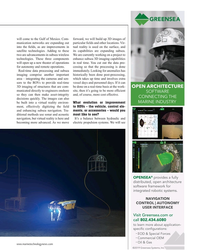 )
March 2019 - Marine Technology Reporter page: 37
)
March 2019 - Marine Technology Reporter page: 37more ef? cient so they can then make asset-integrity and, of course, more cost effective. decisions quickly. The images can also be built into a virtual reality environ- What evolution or improvement ment, effectively digitizing the ? eld to ROVs – the vehicle, control ele- and enhancing subsea navigation
-
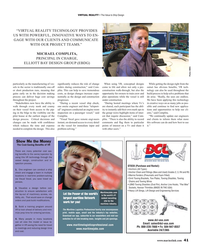 )
February 2019 - Maritime Reporter and Engineering News page: 41
)
February 2019 - Maritime Reporter and Engineering News page: 41VIRTUAL REALITY • The Value to Ship Design “VIRTUAL REALITY TECHNOLOGY PROVIDES US WITH POWERFUL, INNOVATIVE WAYS TO EN- GAGE WITH OUR CLIENTS AND COMMUNICATE WITH OUR PROjECT TEAMS.” MIchAEl coMPlITA, PRINCIPAL IN CHARGE, ELLIOTT BAY DESIGN GROUP (EBDG) Photos: EBDG particularly as the manufacturing of
-
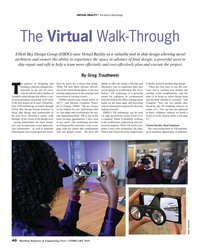 )
February 2019 - Maritime Reporter and Engineering News page: 40
)
February 2019 - Maritime Reporter and Engineering News page: 40VIRTUAL REALITY • The Value to Ship Design The Virtual Walk-Through Elliott Bay Design Group (EBDG) uses Virtual Reality as a valuable tool in ship design allowing naval architects and owners the ability to experience the space in advance of fnal design; a powerful asset in ship repair and reft to help a
-
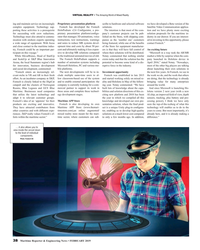 )
February 2019 - Maritime Reporter and Engineering News page: 38
)
February 2019 - Maritime Reporter and Engineering News page: 38VIRTUAL REALITY • The Amazing World of Mixed Reality ing and maintain service on increasingly Proprietary presentation platform scribe to hardware and selected software we have developed a Beta version of the complex equipment. Technology sup- Fostech has developed the Fostech solutions. Satellite
